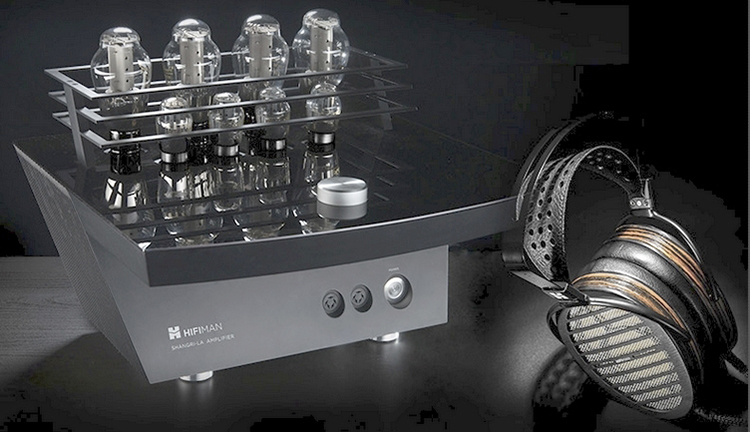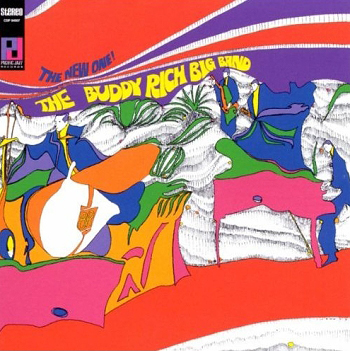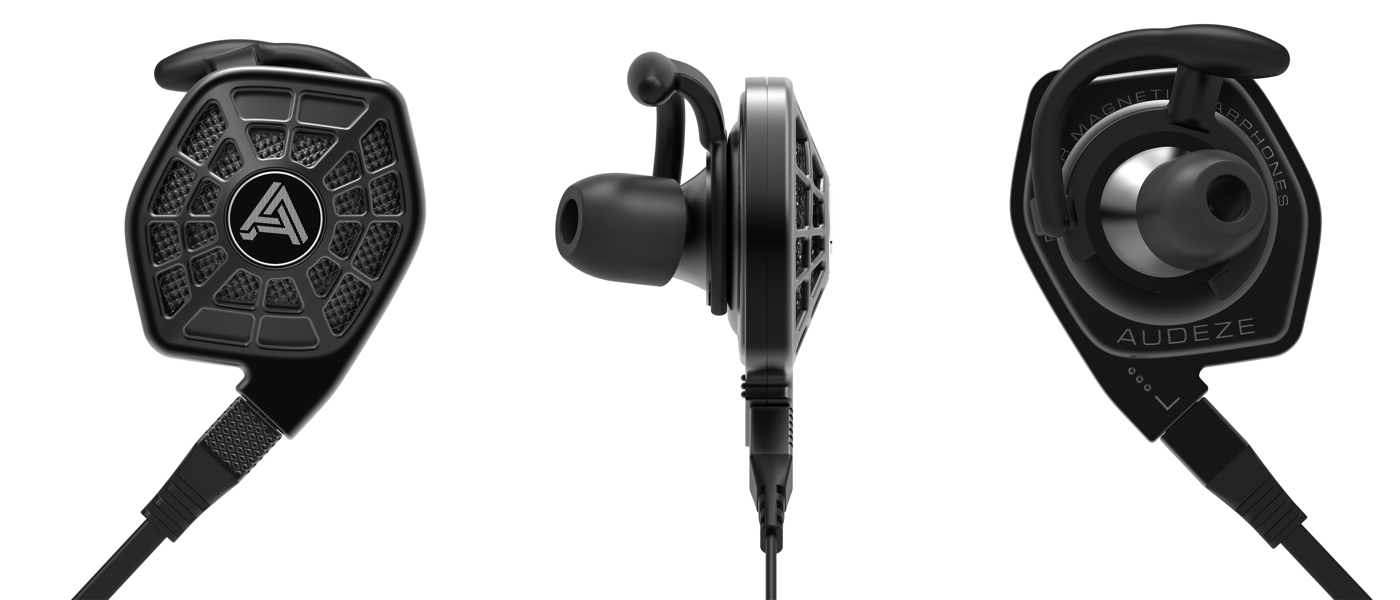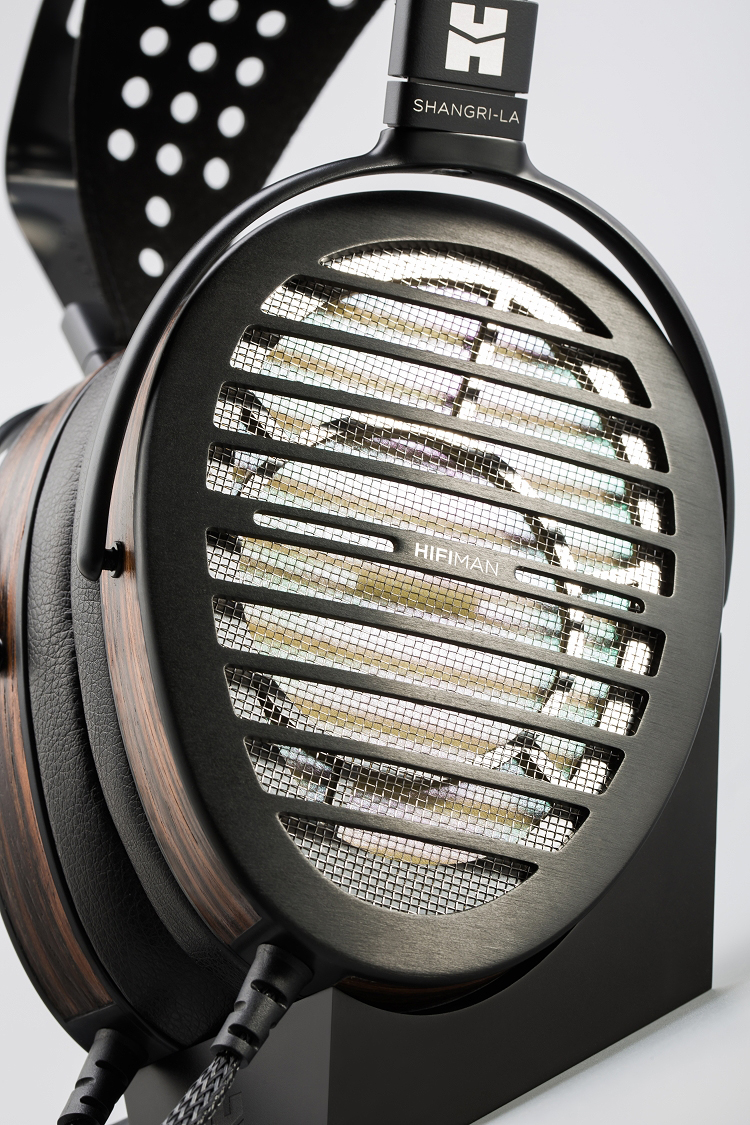Hi-FiMAN markets numerous headphones, most of which are planar-magnetic in design. Dr. Fang Bian, president of HiFiMAN, and others, spent 18 years designing developing his latest products, the Shangri-La electrostatic headphones and an amplifier that is made specifically for the Shangri-La. So, this product is really a sound system.
The sound is very detailed, beyond what any transducer has been capable of before. The headphones are extremely comfortable, and the amplifier is massive.

HiFiMAN Shangri-La Electrostatic Headphones and Pure Class A Amplifier
- Sound that is astonishing
- No transformers anywhere in the signal path
- Headphones are light weight
- Amplifier that is built like a tank
HiFiMAN specializes in headphones, and each year, they introduce new models that set standards in the industry. Their planar-magnetic headphones are superb, and I use their HE-1000’s as one of my references.
However, HiFiMAN continues to innovate, and they finally released a headphone system (headphones and amplifier specifically designed for the new headphones) called the Shangri-La.
DESIGN:
Electrostatic headphones with tube headphone amplifier
FREQUENCY RESPONSE:
7 Hz – 120 kHz
BIAS VOLTAGE ON DIAPHRAGM:
650 Volts
DIAPHRAGM THICKNESS:
1 Micron
TUBE COMPLIMENT:
Four 6SN7 Dual Triodes, Four 300B Triodes
VOLUME CONTROL:
24 Steps, Each with its Own Resistor
DIMENSIONS:
Amplifier: 13.4” H x 18.1” W x 17.3” D
WEIGHT:
Headphones: 13.2 Ounces; Amplifier: 35 Pounds
MSRP:
$50,000 USD
Company:
COUNTRY WHERE MANUFACTURED:
China
SECRETS Tags:
HiFIMAN, Shangri-La, Heaphones, Electrostatic, Triodes, 300B, Pure Class A, Heaphone Reviews 2017
The Shangri-La headphones are electrostatic. Whereas planar-magnetic designs use a diaphragm with a voice coil printed on it, and which is suspended between permanent magnets, electrostatic designs use a diaphragm which is statically charged, and which is suspended between two “stators” that have small holes in them. The amplifier signal is sent to the stators, and the statically charged diaphragm is repelled or attracted to the stators. This moves the air through the stators to your ears.
In general, there is a transformer at the input to electrostatic speakers and headphones. This increases the amplifier voltage to a high level such that the diaphragm will move sufficiently. With headphones, it has been possible to eliminate the transformer because the diaphragm is very small in comparison to the diaphragm in speakers.
The Shangri-La goes one step further in eliminating not only the transformer in the headphones, but also eliminating the output transformer in a newly designed Pure Class A amplifier that uses 300B triodes. Such an amplifier is called an OTL, which means Output Transformer-Less. So, instead of having two transformers between the anode plates on the 300B’s and the stators, there are none. The 300B anode plates are connected directly to the stators in the headphones.300B triodes have a spectacular sound quality, but they are low output. HiFiMAN has managed to design an amplifier that has sufficient output voltage that it will drive the stators to a level that moves the diaphragm enough to reproduce the musical signal at a level which matches their previous planar-magnetic designs.
Secrets Sponsor
Part of how this works is using a diaphragm which is extremely thin, less than 1 micron (1µ). An average human hair is about 60µ in diameter, so you can imagine how thin the diaphragm is. So, the amplifier voltage is enough to do the job without having to use a transformer in the headphones. The 1µ diaphragm is almost massless, which means that it has much lower distortion than would otherwise be produced by a transducer that has more mass, and therefore inertia, which results in harmonics caused by the transducer not responding instantly to the music trying to pull the transducer back when it is moving forward.
Note that mass is different than weight. An object that weighs 6 pounds on earth, weighs 1 pound on the moon, but it has the same mass regardless of where it is. Mass is defined by how much force it takes to move the object. And, it takes almost no force to move the Shangri-La diaphragm. That is what makes it almost distortion-free (I say almost, because no diaphragm – or cone for that matter – is actually massless, and all sound transducers have some distortion).
The bottom line is that consumers will be able to hear the glorious sound of the 300B’s directly.
Listening to the Shangri-La system has been a spectacular experience.
One thing I am sure you have noticed, if you look at the specification box for this review, is that the Shangri-La system is priced at $50,000.
Why so expensive?
The answer is that it took 18 years of R&D (Research and Development) to complete the design, so the costs of doing this must be staggering. There were several people who worked on the project, including Dr. Fang Bian (Ph.D. in chemistry), the president of HiFiMAN, over that two-decade period. The result is something that puts headphone audio on a new plateau. It sounds like the microphones have been moved closer to the musical instruments. Amazing !
The Shangri-La system, with the headphones and amplifier are shown below.
There are four 300B triodes, two for each channel, in a fully balanced circuit. The anode (+) plates of the 300B’s are connected directly to the headphone’s stators, one 300B to each of the two stators in each headphone (left and right ears). The maximum voltage on the stators is 450 volts RMS, 1,200 volts peak.
Two 6SN7 dual triodes are used as the input stage, again, in a fully balanced configuration. One 6SN7 triode is a differential amplifier, and the second 6SN7 triode is a voltage amplifier (a 6SN7 is basically two 6J5 triodes). The entire amplifier is biased into Pure Class A, with two gain stages.
The power supply is solid state, with the voltage on the 300B’s at ± 375 volts.
There is an on/off button on the front, along with two headphone cable connectors, so if you wish, you can purchase a second pair of headphones, and listen to music with a friend or your spouse.
The volume control is a dial on the top of the amplifier, and the rear panel has a pair of balanced (XLR) as well as non-balanced (RCA) audio signal input jacks (top photo in the figure shown below). There are five pins on the headphone cable plug (bottom left photo below shows the two headphone jacks on the amplifier, and the bottom right photo shows the cable plug). Two pins each are for the balanced left and right channels, and the fifth pin is for the bias to the diaphragm. The cable is permanently attached to the headphones, with the five-pin plug on the other end going to the amplifier output jack.
![]()
For the headphones themselves, there is a coating on the diaphragm so that an electrostatic charge can be placed on it. This is accomplished with a 650 +DC voltage on the diaphragm and the – leg of the voltage grounded to the amplifier. The particles on the diaphragm are much less than 1µ in size, which means they are in the “nano-particle” range.
The mesh on the stators consists of wires that are 50µ in diameter. This reduces diffraction (interference of the music waveforms passing by the edges of the openings in the mesh).
The volume control uses a stepped ladder design, with 23 resistors, and as you change the volume, you can hear relays changing the pair of resistors that are in the circuit path. For each volume setting, only one pair of resistors is in the signal path (one resistor per channel).
I asked Dr. Bian about the safety measures that are in place, since there is high voltage on the stators, which are near your ears when you are listening to music. Here is what he said:
“Electrostatic headphone amplifiers are not new. The 580/600 volt standard for electrostatic headphone stators has been in place for 30-40 years, and the current is extremely low. If you touch one of the stators or a conductor in the cable of an electrostatic headphone, you would be 100% safe, and it would only feel like a bite from a mosquito. Regardless of whether the electrostatic headphone amplifier has a transformer or not, there must be 580 volts to 600 volts on the stators, or it would not work. Even solid state electrostatic headphone amplifiers must have a transformer to increase the voltage from several volts to the standard 580/600 volts. There are several large resistors to keep the current at a low value, and there is a relay-based system that cuts off the output if there is a problem in the amplifier, and the power button will turn red.”

I connected the stereo balanced outputs from one of my OPPO BDP-105 universal players, as well as the UDP-205, to the balanced inputs on the Shangri-La amplifier. Music was played from a USB powered hard drive that is connected to a USB input on the BDP-105 and UDP-205. I selected music using the OPPO app that is available on the iTunes store or Android app store. This allows remote control of music selections from an iPhone, iPad, or Android phones and tablets. Albums included 16/44.1 Redbook CD music, as well as high resolution download music. For high resolution music, such as 24/352.8, I played the music files from my computer using JRiver software, and connected a USB output jack on the computer to the USB DAC input on the OPPO BDP-105 or UDP-205.

Windham Hill’s A Winter Solstice IV, is an album that I love dearly, and we play it every day during the week before the 25th of December. Invariably, guests will say they have the album too. My favorite track is “Wexford Carol”. When I listened to it with the Shangri-La headphones, I discovered that the introductory main melody is played by two instruments, a piccolo and a flute, not just one instrument.
These two instruments are both woodwinds, and are closely related. They both play in the same register in this song, so it would be very natural to assume that just one instrument is playing.
I have played this album countless times, and never realized the two-instrument melody (it is also played by a violin in other parts of the track). This ability to deliver tremendous detail is a hallmark of extremely high fidelity, and a result of the 1µ diaphragm.
Buddy Rich was, in just about any jazz and big band circle, the finest drummer who ever lived. He was a perfectionist, who, in my opinion, was the only person ever to achieve perfection. He felt that the drummer should never get in the way of the soloist in his band, be it the tenor sax, trumpet, or other musician. So, the microphones for his drum kit were not close to the drums. The problem with this was that it was difficult to hear his incredible sticking. He was a master of the snare drum, where 95% of his solos were focused.

My favorite Buddy Rich album is The Buddy Rich Big Band: The New One! It is an old album, and it was recorded on analog tape and then reissued in CD form. The best track is, “Away We Go”.
I had been disappointed that I could not hear the solo in detail, but when I listened with the Shangri-La, I could detect more sticking subtleties, enough that I was now as satisfied as I could be, keeping in mind that the album was recorded in 1967.
For those of you who are not familiar with this incredible musician, here is a link to one of his solos.

I use Copland’s Fanfare for the Common Man, on Telarc, for many of my reviews, because it is a fantastic recording, and it pushes any audio product to the limit, because Telarc didn’t use any compression, and the music has some very intense percussion.
The Shangri-La headphones delivered a very realistic sound from the opening huge bass drum thud, to the gong crash. I heard no distortion at all, even though the music was extremely demanding. The bass drum was very tight, meaning that the Shangri-La diaphragm moved only with the music, and not with inertia.

To test the bass response of the HPA-1, I used a download, this one from an old Dorian release of Mussorgsky’s Pictures at an Exhibition. It was performed by Jean Guillou at the Great Organ of the Tonhalle, Zurich, Switzerland.
Track two, “1. Gnomus”, has very low frequency tones, and is another go-to album for my listening tests.
The Shangri-La headphones presented the low pedal tones with a tight, and, again, distortion-free manner.

I have always been a Beethoven fan (what classical music aficionado isn’t?), and one of my favorite albums is his “Emperor” Piano Concerto No. 5, with the pianist Stephen Kovacevich and the London Symphony Orchestra (Decca 478 3350).
The opening keyboard runs from the lowest register all the way to the top are breath-taking, and the Shangri-La headphones made the hairs on the back of my neck stand on end. The sound was as transparent and dynamic as I have every heard, and then some. I could hear not only the notes, but the metal nature of the strings in the piano.
Secrets Sponsor
The headphones are physically transparent as well. There are no cones or magnets in the way to block light, so you can see through them. The open back allows the user to hear sounds in the room, so if your spouse says, “Put the headphones down, and come help me set the table for dinner,” you will hear her. I thought at first room sounds would be distracting, but I became so involved with the music from this incredible audio system, my brain tossed all external sounds aside.

One of my go-to albums these days is the Hymn to the Virgin, downloaded from 2L in Norway. It is available in resolutions up to 24/352.8 PCM and DSD128 (5.6 MHz – twice the resolution of conventional SACD, which is also called DSD64 – 2.8 MHz).
The tracks are just incredible with any transducers, but I was transported to a new level with the Shangri-La headphones. It is music that will bring tears to your eyes, as it did to mine.
Most tube amplifiers use output transformers to obtain a lower output impedance, but often, this results in a roll-off at high as well as low frequencies. The Shangri-La system uses no transformers anywhere, including the amplifier and the headphones input. The sound was lush in the midrange, as 300B triodes are famous for, but also, the highs and lows were not rolled off. So, the HiFiMAN Shangri-Las has the best of both worlds.
I highly recommend the Shangri-La not only to audiophiles at home, but to audio recording and audio mastering studios. The amount of detail that this system can reproduce would greatly enhance the ease and accuracy with which new music can be recorded and mastered to its best.
THE HiFiMAN SHANGRI-LA HEADPHONE SYSTEM IS FOR THOSE WHO WANT TO EXPERIENCE MUSIC IN A WAY THAT IS REVOLUTIONARY, and who are willing to pay the price for 20 years of development.
- Unique sound that is un-paralleled
- Headphones are very comfortable
- Pure Class A 300B headphone amplifier, with terrific, lush characteristics, and no output transformer
- A 20-foot headphone extension cord
- Volume level read-out, perhaps just a row of LEDs
- Remote control of volume








